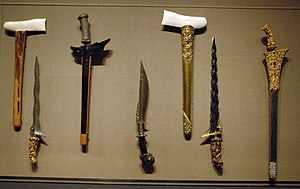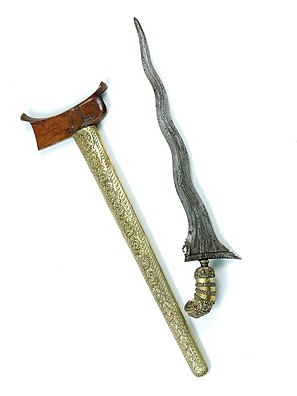
Back كريس (سلاح) Arabic Kadutan BAN Крыс Byelorussian Крыс BE-X-OLD Karis BJN কিরিচ Bengali/Bangla Kris (arma) Catalan Kris Czech Kris German Kriso Esperanto
| Kris | |
|---|---|
 | |
| Country | Indonesia |
| Criteria | Traditional craftsmanship |
| Reference | 112 |
| Region | Asia and the Pacific |
| Inscription history | |
| Inscription | 2008 (3rd session) |
| List | Representative List |
 The kris or keris is a distinctive, asymmetrical dagger from the Indonesian island of Java. Both weapon and spiritual object, the kris is considered to possess magical powers. The earliest known kris goes back to the tenth century and spread from the island of Java throughout Southeast Asia. | |
The kris or keris[n 1] is a Javanese asymmetrical dagger with a distinctive blade-patterning achieved through alternating laminations of iron and nickelous iron (pamor).[8] The kris is famous for its distinctive wavy blade, although many have straight blades as well, and is one of the weapons commonly used in the pencak silat martial art native to Indonesia. Kris have been produced in many regions of Indonesia for centuries, but nowhere—although the island of Bali comes close—is the kris so embedded in a mutually-connected whole of ritual prescriptions and acts, ceremonies, mythical backgrounds and epic poetry as in Central Java.[9]: 27 Within Indonesia the kris is commonly associated with Javanese culture, although other ethnicities in it and surrounding regions are familiar with the weapon as part of their cultures, such as the Balinese, Sundanese, Malay, Madurese, Banjar, Buginese, and Makassar people.[10] The kris itself is considered as a cultural symbol of Indonesia[2]: 266 and also neighbouring countries like Brunei, Malaysia,[11] Philippines, Singapore, and Thailand.
A kris can be divided into three parts: blade (bilah or wilah), hilt (hulu), and sheath (warangka). Each part of the kris is considered a piece of art, often carved in meticulous detail and made from various materials: metal, precious or rare types of wood, or gold or ivory. A kris's aesthetic value covers the dhapur (the form and design of the blade, with around 60 variants), the pamor (the pattern of metal alloy decoration on the blade, with around 250 variants), and tangguh referring to the age and origin of a kris.[12] Depending on the quality and historical value of the kris, it can fetch thousands of dollars or more.
Both a weapon and spiritual object, kris are often considered to have an essence or presence, considered to possess magical powers, with some blades possessing good luck and others possessing bad.[12] Kris are used for display, as talismans with magical powers, weapons, a sanctified heirloom (pusaka), auxiliary equipment for court soldiers, an accessory for ceremonial dress, an indicator of social status, a symbol of heroism, etc.[12] Legendary kris that possess supernatural power and extraordinary ability were mentioned in traditional folktales, such as those of Empu Gandring, Taming Sari, and Setan Kober.
In 2005, UNESCO awarded the kris the status of Masterpiece of the Oral and Intangible Heritage of Humanity.[12]
- ^ "Keris Indonesia". Kebudayaan.kemendikbud.go.id (in Indonesian). Retrieved 2020-08-22.
- ^ a b Top 100 Cultural Wonders of Indonesia. Jakarta: Ministry of Education and Culture of the Republic of Indonesia. 2015. ISBN 978-979-1274-66-1.
- ^ Pires, Tomé (1990). The Suma Oriental of Tome Pires: An Account of the East. New Delhi: Asian Educational Services. p. 179. ISBN 81-206-0535-7.
- ^ Albert G Van Zonneveld (2002). Traditional Weapons of the Indonesian Archipelago. Koninklijk Instituut Voor Taal Land. ISBN 90-5450-004-2.
- ^ James Richardson Logan (1853). The Journal of the Indian Archipelago and Eastern Asia, Volume 7. Miss. Press. p. 281.
- ^ Sudaryanto, Pranowo (2001). Kamus Pepak Basa Jawa (in Javanese). p. 1359.
- ^ See: Javanese language: Politeness
- ^ Tantri Yuliandini (April 18, 2002). "Kris, more than just a simple dagger". The Jakarta Post. Archived from the original on 29 July 2014. Retrieved 30 July 2014.
- ^ Groneman, Isaäc (2009). "The Javanese Kris" (PDF). Leiden: Leiden and KITLV Press. Archived from the original (PDF) on 10 August 2014. Retrieved 29 July 2014.
- ^ Clark, Marshall; Pietsch, Juliet (2014). Indonesia-Malaysia Relations: Cultural Heritage, Politics and Labour Migration. Routledge. pp. 54–7. ISBN 9780415788014.
- ^ Bendeich, Mark (Nov 6, 2007). "Malaysia's political knife act: theatre or threat?". Reuters.
- ^ a b c d "UNESCO - Indonesian Kris". ich.unesco.org. Retrieved 2020-10-24.
Cite error: There are <ref group=n> tags on this page, but the references will not show without a {{reflist|group=n}} template (see the help page).
© MMXXIII Rich X Search. We shall prevail. All rights reserved. Rich X Search
